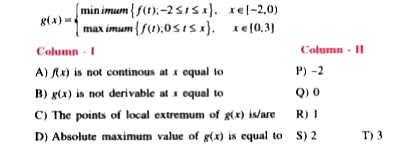Let f(x)=ln(2x−x2)+sin(πx2) then Solution in Telugu
graph of is symmetrical about the line x=1
Maximum value of f is 1
Absolute minimum value of f does not exist
f(x) is a periodic function
The correct Answer is:A, B, C, D
Step by step video, text & image solution for Let f(x)=ln(2x-x^(2))+sin((pi x)/(2)) then by Maths experts to help you in doubts & scoring excellent marks in Class 11 exams.
Topper's Solved these Questions
- BOOK - AAKASH SERIESCHAPTER - MAXIMA AND MINIMA EXERCISE - PRACTICE SHEET (EXERCISE -II) (LEVEL -II) (MATRIX MATCHING TYPE QUESTIONS)2videos
MAXIMA AND MINIMA
- BOOK - AAKASH SERIESCHAPTER - MAXIMA AND MINIMA EXERCISE - PRACTICE SHEET (EXERCISE -II) (LEVEL -II) (LINKED COMPREHENSION TYPE QUESTIONS )6videos
MAXIMA AND MINIMA
- BOOK - AAKASH SERIESCHAPTER - MAXIMA AND MINIMA EXERCISE - PRACTICE SHEET (EXERCISE -II) (LEVEL -I) (STRAIGHT OBJECTIVE TYPE QUESTIONS)69videos
MAXIMA AND MINIMA
- BOOK - AAKASH SERIESCHAPTER - MAXIMA & MINIMAEXERCISE - EXERCISE-III35videos
MAXIMA & MINIMA
- BOOK - AAKASH SERIESCHAPTER - MEAN VALUE THEOREMSEXERCISE - PRACTICE SHEET (EXERCISE-I (LEVEL-II (MORE THAN ONE CORRECT ANSWER TYPE QUESTIONS ) )2videos
MEAN VALUE THEOREMS
Similar Questions
Let f(x) be a real valued function defined by f(x)=x2−2|x| an
g(x) 03:12View Solution
03:12View SolutionIf f11(x)<0(>0) on an interval (a,b) then the curve y=f(x) on this interval is convex (concave) i.e it is below (above) any of its tangent lines If f11(x0)=0 or does not exist and the second derivative changes sign when passing through the point x0 then the point (x0,f(x)) is the = point of inflection of the curve y=f(x)
If y=x4+x3−18x2+24x−12 then11:48View SolutionThe smallest value of x2−3x+3 in the interval [−3,32] is
08:57View SolutionThe maximum slope of the curve y=−x3+3x2+9x−27 is
01:56View SolutionGiven f(x) = 4- ((1)/(2) - x)^(2//3) , g(x) = {:{((tan[x])/(x),","x cancel(=)0),(1,","x=0):}" "h(x)={x}, k (x) = 5^(log_(2)(x+3))
Then in [0,1], Lagrange's mean value theorem is not applicable to (where [.] and {.} represents the greatest integer functions and fractions part functions, respectively )04:43View SolutionLet f(x)=∫xsinx(1+xcosx.lnx+sinx)dxandf(π2)=π24. Then the value of |cos(f(π))| is____
03:39View SolutionLet f(x)=(1-sin x)/((pi-2x)^(2))*(ln(sin x))/(ln(1+pi^(2)-4 pi x+4x^(2))),x!=(pi)/(2). The value of f((pi)/(2)) so that the function is continuous at x=(pi)/(2) is:
03:18View SolutionConsider a function,f(x)=(2)/(3)ln(sin x+cos x)^((3)/(2)) for x in(0,(pi)/(2)) The value of lim_(x rarr(pi)/(2))(f(x))/((pi)/(2)-x) is
10:39View Solutionf (x) = ln (sin x) ^ (2) then f ((pi) / (4)) =
02:31View SolutionThe tatal number of solutions of ln|sin x|=-x^(2)+2x in[-(pi)/(2),(3 pi)/(2)] is equal to
View Solutionlet f(x)=(ln(x^(2)+e^(x)))/(ln(x^(4)+e^(2x))) then lim_(x rarr oo)f(x) is
03:32View SolutionLet f(x)=√log(2x−x2). Then dom (f )=?
04:26View Solutionयदि f(x)=⎧⎪⎨⎪⎩1−sinx(π−2x)2logsinxlog(1+π2−4πx+4x2),x≠π2k,x=π2
x=π2 पर सतत हो, तो k का मान होगा -View SolutionLet f(x)=⎧⎨⎩1+cosx(π−x)2.sin2xln(1+π2−2πx+x2)x≠πλx=π
03:06View Solution∫π/2−π/2sin2xlog(2−sinx2+sinx)dx is :
View SolutionLet f(x)=2x2−logx, then
04:12View Solution

